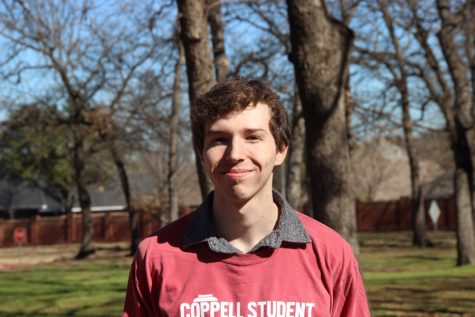Convention opens staffer to new perspective
The CBS newsroom reporters all work on their stories as members of Coppell Student Media are given a tour around the CBS Studios Center in Los Angeles on Thursday. Members of The Sidekick and KCBY were able to talk with many different journalists and learn about the professional news company.
April 17, 2016
LOS ANGELES – It’s hard to define this weekend for me as a first-time staff member attending the JEA/NSPA Spring National High School Journalism Convention. However, I sensed that there was an underlying theme of “what is the role of a journalist?” and for me, I was presented with several options, all of which work for journalism within the 21st century.
The first keynote of the convention was scheduled for our first night there. It was presented by Jose Antonio Vargas on a case study of his work which centers around individual identity as an American and the social injustice that often follows. Vargas is a Pulitzer Prize journalist and filmmaker as well as the founder of #EmergingUS.
Another keynoter of the evening was Amara Aguilar whose speech focused on two things: marketing more online content to a journalist’s audience, and finding that key balance between hard hitting coverage and more light-hearted story telling. Aguilar is the associate professor of professional practice in digital journalism at the University of Southern California Annenberg School for Communication and Journalism.
In addition to these brilliant speakers and their above-and-beyond oratory skills, I also attended lectures for news coverage of protests, knowing your rights under the first amendment in public and private spaces, and more interestingly, dropping the journalistic f-bomb. The F was actually about filing a Freedom of Information Act form for research, but it was still pretty cool.
But how does this tie into the role of a journalist? Sure these are things journalists need to know in order to mature and above all to stay safe, but how does this specifically relate? How does the question “what is the importance of microblogging and has it contributed significantly to journalism” relate to the role(s) of being a grade-A writer of the free press? More importantly, how am I supposed to figure this out when this is my first convention?
This convention in a way feels to me like a climax if my first year of being on The Sidekick staff. I learned not only how to improve my writing and work in a more professional setting, but I learned from different perspectives bits and pieces of the role of journalists. According to Stan Zoller, the speaker on the subject, a journalist must first “…protect the public’s right to know.”
What now makes this more complicated is not the answer, but the approach. How do you go about protecting the public’s right to know? It seemed that every speaker in their lecture had a different approach. Even graphics play an important role in the delivery of content to an audience, just as technology also plays a role in delivering that content (hence the contribution of Twitter microblogging).
It seems to be that the best approach is every approach as long as it works for you. Every successful journalist has found a balance between those addictive buzzfeed-style short videos and those more dense Christiane Amanpour interviews. Not only is there that balance of content, but there must also be that balance of delivery.
The 21st century has opened up so many different platforms of digital media that it’s a crime worthy of coverage not to use those platforms. Journalists must immerse themselves in this digital frontier of analytical writing in order to, at the end of the day, fulfill their role – to protect the public’s right to know. Thankfully, I can leave knowing that I have the knowledge and the resources to do just that.










